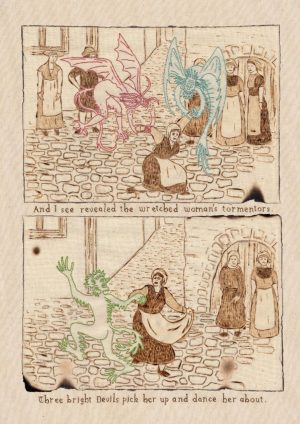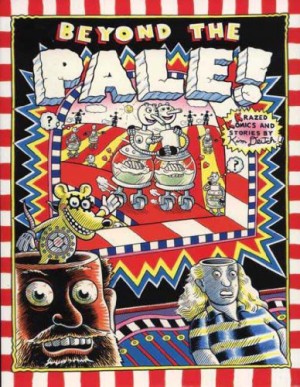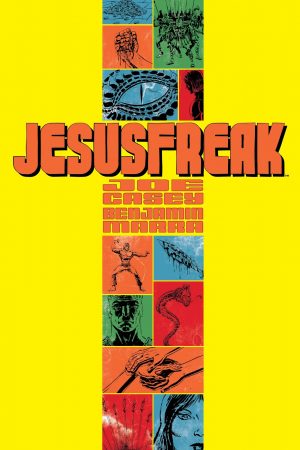Review by Karl Verhoven
What at first seems a bizarre pseudo-religious fantasy presented as fact by Gareth Brookes turns out to be historically documented, if perhaps not entirely factually correct. What can be widely found online is that in July 1518 a woman named Frau Troffea from Strasbourg, now home of the European parliament, began dancing in the street. She was joined by others for a phenomenon said to have lasted many days. Taking the events as true, modern day theories as to the cause range from the all-encompassing mass hysteria to the more considered possibility of fungal infected grain. Isn’t it much more satisfying, though, to view it as genuine possession by devils? That’s how it was considered at the time, and is how Brookes chooses to view it, placing it in the context of the period’s general religious beliefs when so much was viewed as Satanic influence or an act of God.
He takes this verisimilitude far further, illustrating The Dancing Plague using the form of flat drawings to be found in medieval manuscripts, when necessary complete with haunted, contorted faces. These are simple, mostly presented in brown with the brown coloured paper further suggesting age, and generously overlaid with demons interacting with people, these outlined in different colours and only selectively visible. Occasional brighter interludes supply the spiritual highs. It’s all in service of investigating life in the middle ages, the power dynamics, the misguided beliefs, the fanaticism and the seemingly absolute power of the church and its representatives. From the hindsight of the 21st century it makes for depressing reading. “You are, are you not, a woman?”, a priest denounces toward the end, “Each of you is an Eve. The Devil’s gateway, the unsealer of sin”. In the 1500s challenging such nonsense was contradicting the church, which had serious consequences
At his best Brookes presents a convincing extrapolation of tragedy, the central figure becoming Mary, the one person able to view the dancing demons. As a child she genuinely spoke the word of God, denouncing the corrupt local priest, and so making life very difficult for her family. It mirrors other aspects of The Dancing Plague, and holds that same mirror to our own society’s habit of ignoring inconvenient truths in favour of comfort. Mary’s story offers some surprising delights amid a generally jaw-dropping life of betrayal and repression. A nice artistic touch is some pages having a slight burned effect, as if the book has been rescued from a church disposal of heretical tomes.
Symbolic visions and horror notwithstanding, and as engrossing as he is in places, Brookes can wander on too long. Sections are extended beyond the point convincingly made. It’s true to a form of medieval literature, where the raconteur regales at length, the necessary not sifted from the unnecessary, which diminishes the better aspects. These do predominate, but the meandering can’t be ignored.
Brookes treats events as unfortunate and tragic, but it should be stressed that he presents nothing as ridicule. The thoughtful reader will be prompted to consider how far we really have progressed, and wonder when viewed in five hundred years time how many of our truths and convictions will be seen in the same way.





